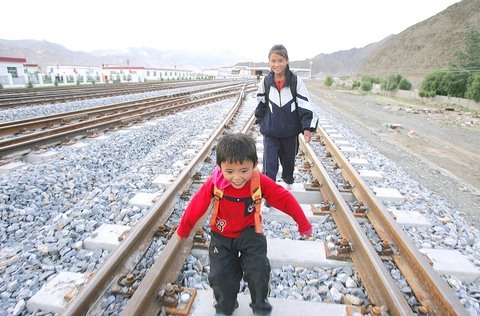China unveils an engineering marvel this weekend -- a railway to Tibet that features high-tech systems to stabilize tracks over permafrost and oxygen-enriched cabins to help riders cope with high altitudes.
Yet, as with so much else in China's often harsh 56-year rule over Tibet, the 1,140km-long railway to the Tibetan capital has drawn controversy, even before the first train's departure, scheduled for today.
Critics, including Tibetans loyal to the exiled Dalai Lama, say the US$4.2 billion railway is part of a campaign by Beijing to crush Tibetan culture by encouraging an influx of Han Chinese, China's majority ethnic group.

PHOTO: AP
Environmentalists worry about the railway's impact on Tibet's highlands.
The train "will mean more environmental destruction for Tibet, more unemployment for Tibetans and of course our culture will be devastated," said Ngawang Woeber, a member of Gu Chu Sum, an India-based support group for former Tibetan political prisoners.
Pro-independence groups planned to wear black armbands in protest and demonstrate outside Chinese embassies today, a campaign they call "Reject the Railway."
Railway official Zhu Zhensheng said the project will boost Tibet's economy and help people learn about its unique culture. Zhu said few Tibetans will work on the train at first, though "we hope to increase those opportunities."
Yesterday, three foreign protesters were detained in Beijing after holding a brief demonstration at the capital's main train station.
The women from the US, Canada and Britain unfurled a banner that read in English, "China's Tibet Railway, Designed to Destroy," before two police officers escorted. It was not immediately clear where they were taken.
Railway Ministry officials on Thursday previewed the new rail line from the city of Golmud to Tibet's capital, Lhasa, saying it's the world's highest, taking 5,000m passes at 100kph.
The line -- sometimes called the "Sky Train" -- is a "major achievement" that will "hugely boost local development and benefit the local people," said Zhu, vice director of the Railway Ministry's Tibetan Railway Office.
When construction on the line was completed last year, Chinese President Hu Jintao (
The railway is projected to help double tourism revenues by 2010 and reduce transport costs for goods by 75 percent, the government's Xinhua News Agency said.
Chinese officials have thought for decades about building Tibet railway. China's rail system reached Golmud in Qinghai province, nearly 3,000km from Beijing, by 1984.
But railway officials said it was too difficult to extend the line to Tibet due to huge swaths of permafrost and extreme temperatures.
The plan was resurrected in 2001. Engineers determined they could build elevated bridges over the most unstable permafrost. In other places, they could sink pipes with cooling elements into the ground to stabilize track embankments, ensuring they stayed frozen.
"It's kind of like non-electric refrigeration," Zhu said.
The train cars, manufactured by Canada's Bombardier Inc, have double-pane windows with ultraviolet filters to protect passengers from the sun's glare, and carefully regulated oxygen levels in all classes.
The trip from Beijing to Lhasa will take 48 hours; officials have yet to decide if there will be daily trains.
Though the technology is new, the strategy of using trains and commerce to tamp down restive ethnic groups in China is not. Campaigns to integrate Inner Mongolia and the Muslim Xinjiang region in the far west were aided by rail links that ferried in millions of Chinese -- sometimes voluntarily, sometimes not -- to firm up Beijing's control.
Despite the rosy economic forecasts and dire predictions of Chinese control, the train is unlikely to touch off social disaster or commercial windfall, said Andrew Fischer, an economics researcher at the London School of Economics.
Fischer said that daily flights and overland links have given Chinese interested in Tibet a way to migrate for decades, that tourism is likely to stabilize at only slightly higher than the current rates, and that exploiting Tibet's natural reserves will remain prohibitively expensive.
The main reason for the project is symbolic, he said: "It's the last frontier they have been dreaming of for the last century."
For now, the Dalai Lama, in exile since 1959 but still the spiritual leader of Tibetan Buddhists, is taking a wait-and-see attitude.
"The railway line itself is not a cause of concern for the Tibetan people," said Thupten Samphel, spokesman for the Dalai Lama's government in exile. "How it will be used is the main concern."

Swedish campaigner Greta Thunberg was deported from Israel yesterday, the Israeli Ministry of Foreign Affairs said, the day after the Israeli navy prevented her and a group of fellow pro-Palestinian activists from sailing to Gaza. Thunberg, 22, was put on a flight to France, the ministry said, adding that she would travel on to Sweden from there. Three other people who had been aboard the charity vessel also agreed to immediate repatriation. Eight other crew members are contesting their deportation order, Israeli rights group Adalah, which advised them, said in a statement. They are being held at a detention center ahead of a

A Chinese scientist was arrested while arriving in the US at Detroit airport, the second case in days involving the alleged smuggling of biological material, authorities said on Monday. The scientist is accused of shipping biological material months ago to staff at a laboratory at the University of Michigan. The FBI, in a court filing, described it as material related to certain worms and requires a government permit. “The guidelines for importing biological materials into the US for research purposes are stringent, but clear, and actions like this undermine the legitimate work of other visiting scholars,” said John Nowak, who leads field

Former Nicaraguan president Violeta Chamorro, who brought peace to Nicaragua after years of war and was the first woman elected president in the Americas, died on Saturday at the age of 95, her family said. Chamorro, who ruled the poor Central American country from 1990 to 1997, “died in peace, surrounded by the affection and love of her children,” said a statement issued by her four children. As president, Chamorro ended a civil war that had raged for much of the 1980s as US-backed rebels known as the “Contras” fought the leftist Sandinista government. That conflict made Nicaragua one of

NUCLEAR WARNING: Elites are carelessly fomenting fear and tensions between nuclear powers, perhaps because they have access to shelters, Tulsi Gabbard said After a trip to Hiroshima, US Director of National Intelligence Tulsi Gabbard on Tuesday warned that “warmongers” were pushing the world to the brink of nuclear war. Gabbard did not specify her concerns. Gabbard posted on social media a video of grisly footage from the world’s first nuclear attack and of her staring reflectively at the Hiroshima Peace Memorial. On Aug. 6, 1945, the US obliterated Hiroshima, killing 140,000 people in the explosion and by the end of the year from the uranium bomb’s effects. Three days later, a US plane dropped a plutonium bomb on Nagasaki, leaving abut 74,000 people dead by the